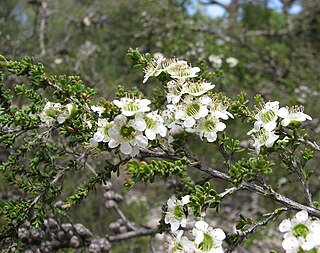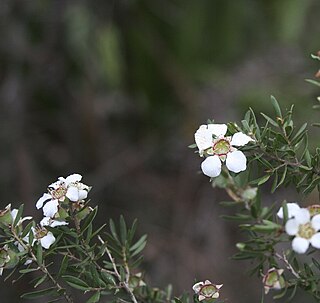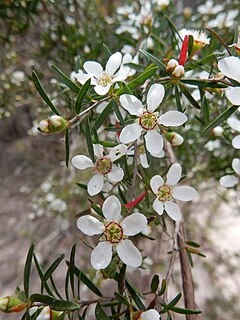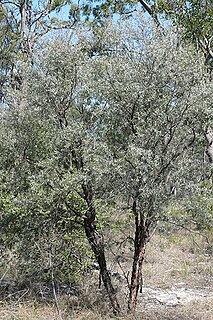
Leptospermum liversidgei, commonly known as the olive tea-tree, is a species of compact shrub that is endemic to eastern Australia. It has narrow egg-shaped, lemon-scented leaves, white or pink flowers and woody fruit that remain on the plant at maturity.

Leptospermum trinervium, commonly known as flaky-barked tea-tree, slender tea-tree or paperbark tree, is a species of shrub or small tree that is endemic to eastern Australia. It has papery bark that is shed in thin, flaking layers, narrow elliptic to broadly egg-shaped leaves with the narrower at the base, white flowers and silky-hairy fruit that falls from the plant when mature.

Leptospermum juniperinum, commonly known as the prickly tea tree, is a species of broom-like shrub that is endemic to eastern Australia. It has narrow, sharply pointed leaves, white flowers usually arranged singly on short side shoots and small fruit that remain on the plant when mature.

Leptospermum deuense is a species of shrub that is endemic to New South Wales. It is a leafy, densely branched shrub with rough bark on the older stems, elliptical leaves with a glossy upper surface, white flowers arranged singly or in pairs and woody fruit.

Leptospermum obovatum, commonly known as river teatree, is a species of shrub that is endemic to south-eastern continental Australia. It has egg-shaped or lance-shaped leaves that are narrower at the base, white flowers usually arranged singly on short side shoots and fruit that remains on the plant until it dies.

Leptospermum parvifolium, commonly known as lemon-scented tea-tree, is a species of shrub that is endemic to eastern Australia. It has thin, rough bark, egg-shaped leaves with the narrower end towards the base, white or pink flowers, and fruit with the remains of the sepals attached but that is shed when the seeds are mature.

Leptospermum deanei, commonly known as Deane's tea-tree, is a species of rare, slender shrub that is endemic to the northern suburbs of Sydney. It has bark peeling in long strips from the older stems, hairy young stems, narrow elliptical to lance-shaped leaves, white flowers arranged singly on short side shoots and mostly glabrous fruit.

Leptospermum anfractum is a species of spreading shrub that is endemic to Queensland. It has a smooth, twisted trunk, linear leaves, white flowers borne in leaf axils and bell-shaped to hemispherical fruit. It grows on rocky ridges and cliff edges.

Leptospermum blakelyi is a species of shrub that is endemic to rocky clifftops near Lithgow in New South Wales. It has densely silky young stems, egg-shaped to elliptical leaves and white or pink flowers.

Leptospermum brevipes, commonly known as the slender tea-tree, is a species of shrub or small tree that is endemic to eastern Australia. It has fibrous bark on the main stems, smooth bark on young stems, narrow elliptical to narrow egg-shaped leaves, white flowers and hemispherical fruit that is shed when mature.

Leptospermum divaricatum is a species of plant that is endemic to inland New South Wales. It is an erect or weeping shrub with compact fibrous bark, elliptical to egg-shaped leaves, white flowers arranged singly on short axillary side shoots and woody fruit that fall off when mature.

Leptospermum glabrescens, commonly known as the smooth teatree, is a shrub or small tree that is endemic to East Gippsland in Victoria, Australia. It has linear, elliptic or narrow egg-shaped leaves, white flowers arranged singly on short side shoots and fruit that remain on the plant.

Leptospermum lamellatum is a species of shrub or small tree that is endemic to inland Queensland and has distinctive reddish, layered bark. It has narrow elliptical leaves, white flowers and small fruit that fall from the plant when mature.
Leptospermum minutifolium, commonly known as the small-leaved tea-tree, is a species of shrub that is endemic to eastern Australia. It has relatively small egg-shaped leaves, white flowers borne singly on the ends of branches and fruit that remains on the plant.

Leptospermum myrtifolium, commonly known as the myrtle tea-tree or grey tea-tree, is a species of shrub that is endemic to south eastern Australia. It has broad egg-shaped to elliptical leaves, white flowers usually borne singly on short side shoots, and fruit that remains on the plant until it dies.

Leptospermum namadgiense is a species of small shrub that is endemic to areas near the border between New South Wales and the Australian Capital Territory. It has silky-hairy, narrow lance-shaped to elliptical leaves, usually white flowers borne singly or in pairs on short side shoots, and fruit that falls from the plant shortly after the seeds are released.

Leptospermum purpurascens, commonly known as the purple-stemmed turkey bush, is a shrub or small tree that is endemic to far north Queensland. It has bark that is purple when new, elliptical to broadly lance-shaped leaves, relatively small white flowers arranged in pairs and small fruit that falls from the plants when the seeds are released.

Leptospermum semibaccatum is a species of low, dense shrub that is endemic to eastern Australia. It has egg-shaped to narrow elliptical leaves with a blunt tip, white or pink flowers and hairy, flat-topped fruit that falls from the plant shortly after the seeds are released. It grows in poorly-drained soil in coastal heath.

Leptospermum subglabratum is a species of open shrub that is endemic to a south-eastern New South Wales. It has thin, rough bark, egg-shaped to lance-shaped leaves with the narrower end towards the base, white flowers arranged singly on short side shoots and relatively small fruit that falls from the plant at maturity.

Leptospermum wooroonooran, commonly known as wurunuru or mountain teatree, is a species of stunted tree that is endemic to Queensland where it grows on exposed mountain ridges. It has thin, fibrous or flaky bark, lance-shaped leaves with the narrower end towards the base, white flowers arranged singly on short side shoots and fruit remain on the plant at maturity.



















